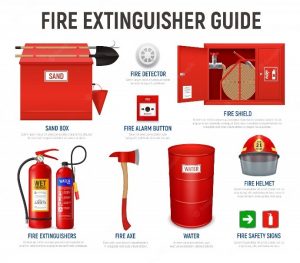Fire Fighting (Detection) Systems

RADIATION FLAME DETECTOR
Flame detectors activate in response to radiant energy generated by the lame or combustion. Two types of lame detectors are commonly used. They include ultraviolet (UV) detectors and the infrared (IR) detectors.
Infrared detectors operate at wavelengths above 7000 Angstrom. Therefore, they operate efficiently when separated from the lame by height and distance. Infrared lame detectors are often used in large, open, hazardous areas where there is a possibility for an immediate lame producing fire such as a flammable liquid fire. The wavelengths visible to the human eye range are between 4000 and 7000 Angstrom or from violet to red on the colour spectrum. Flame detectors discriminate between fire-induced optical radiation and natural or artificial illumination. The ability to distinguish between fire and non-fire radiation is an essential feature of an effective lame detector. An infrared detector has a filter and lens system that screens out certain wavelengths and focuses infrared waves on a photoelectric cell. Infrared detectors respond within 50 to 100 milliseconds to a 1-square-foot fire at 25 feet.
ULTRAVIOLET FLAME DETECTOR
The ultraviolet lame detector is designed to operate on the ultraviolet wavelengths below 4000 Angstrom. These wavelengths are primarily emitted by higher intensity lames. Most fires will have lames of sufficient intensity to produce wavelengths in the 2800–3000 Angstrom range. A major problem of ultraviolet lame detectors is that radiation from sunlight may be as low as 2900 Angstrom, which could cause false alarms (Bryan, 1974).
There are ultraviolet detectors that have been designed to respond to fire-induced optical radiation below 2900 Angstrom and not to respond to solar radiation at the same levels. One of these designs is the gas-discharge-type unit. This unit has been tested and found effective to the 2850 Angstrom level. Another effective type is the photosensitive silicon carbide diode. The photosensitive silicon carbide diode detector is very effective in enriched oxygen atmosphere at high pressure, but the detector still has difficulties with non-fire radiation. These types of detectors are excellent as explosion suppression system activators. One other type of ultraviolet detector that has been tested and found effective is the molybdenum crystal detector.
THERMAL DETECTORS
The design of thermal detectors permits them to operate from thermal output or the heat from a fire. Laminar and turbulent convection air currents disperse the heat from the fire throughout the area. Turbulent airflow is induced and regulated by the fire plume thermal-column effect of rising heated air and gases above the fire surface. Knowledge of fire-induced thermal dispersion is important because the rate of heat production from a fire and its distribution within an area are essential to the correct placement and operation of a thermal detector. Two of the main hazards associated with fires are thermal radiation and smoke and this is where the thermal detector aids the safety practitioner in determining what to do in abating the problem.
SMOKE DETECTORS
Smoke detectors respond to the visible and invisible products of combustion. The visible products consist mainly of unconsumed carbon and carbon-rich particles. The invisible products consist mainly of solid particles smaller than five microns. There are two basic types of smoke detectors: the combustion products type and the photoelectric type.
The photoelectric smoke detector works by passing air through an enclosed unit with a light mounted at one end and the photoelectric cell at the other. As smoke particles are drawn into the unit and the reduced level of light intensity causes an unbalanced condition in the electrical circuit to the photoelectric cell, the detector is activated.
AIR SAMPLING DETECTOR
By the mid-1970s, it became necessary to compensate for the disadvantages of conventional fire detection technologies. Engineers in Australia created air sampling detection systems suitable for use in computer rooms, telecommunications facilities, offices, and residences. An air sampling system has an air transport system, filters to remove large dust particles, an optical detector to test the air, an air pump to move samples through the system, and a controller to interpret the detector results.
An air sample is drawn into the detector from the air transport system. Dust is filtered out to prevent contamination. The air sample is then exposed to a xenon light and drawn out by an aspirator. The light signal is transmitted to a photoelectric cell and passed on to a control card for processing onto a bar-graph representation of the smoke level. A stream of air is continuously drawn into and expelled from the detector (Lavelle, 1992).
For more information on Safety Training do click this link to MASMA Safety or click here for more information. Do not hesitate to call us at 019-2000643. MASMA Fire Engineering – Your Trusted Fire Contractor.
